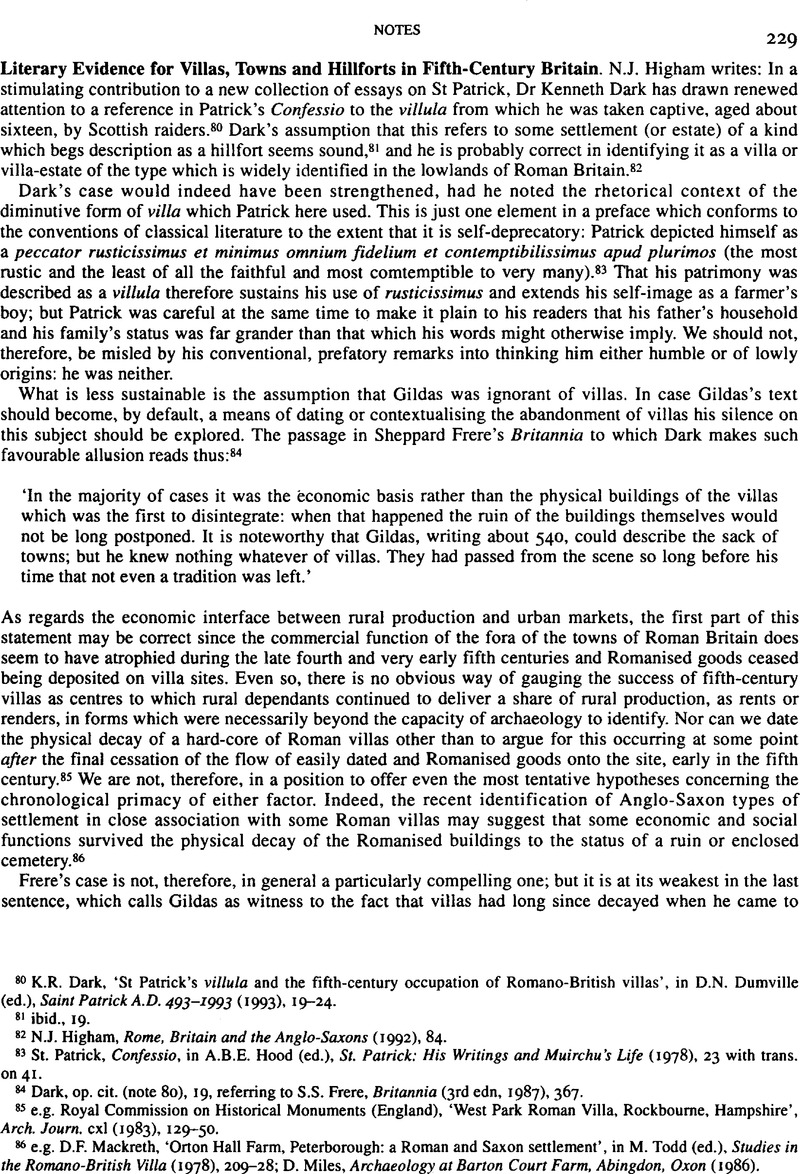No CrossRef data available.
Article contents
Literary Evidence for Villas, Towns and Hillforts in Fifth-Century Britain
Published online by Cambridge University Press: 09 November 2011
Abstract

- Type
- Notes
- Information
- Copyright
- Copyright © N.J. Higham 1994. Exclusive Licence to Publish: The Society for the Promotion of Roman Studies
References
80 K.R. Dark, ‘St Patrick's villula and the fifth-century occupation of Romano-British villas’, in D.N. Dumville (ed.), Saint Patrick A.D. 493-1993 (1993), 19-24.
81 ibid., 19.
82 N.J. Higham, Rome, Britain and the Anglo-Saxons (1992), 84.
83 St. Patrick, Confessio, in A.B.E. Hood (ed.), St. Patrick: His Writings and Muirchu's Life (1978), 23 with trans, on 41.
84 Dark, op. cit. (note 80), 19, referring to S.S. Frere, Britannia (3rd edn, 1987), 367.
85 e.g. Royal Commission on Historical Monuments (England), ‘West Park Roman Villa, Rockbourne, Hampshire’, Arch. Journ. cxl (1983), 129–50.Google Scholar
86 e.g. D.F. Mackreth, ‘Orton Hall Farm, Peterborough: a Roman and Saxon settlement’, in M. Todd (ed.). Studies in the Romano-British Villa (1978), 209-28; D. Miles, Archaeology at Barton Court Farm, Abingdon, Oxon (1986).
87 M. Winterbottom (ed.), Gildas: The Ruin of Britain and Other Documents (1978).
88 The most authoritative defence of the traditional date is that of D.N. Dumville, ‘The chronology of De Excidio Britanniae, Book I’, in M. Lapidge and D.N. Dumville (eds), Gildas: New Approaches (1984), 61-84; for a revision, see N.J. Higham, The English Conquest: Gildas, Britain and the Saxons (1994), 118-45.
89 ibid, 7-34.
90 D(e) E(xcidio) B(ritanniae) III.2; X.2; XVIII.2; XIX.3; XXIV; XXVI.2.
91 DEB I. 4-5.
92 As in XXIV.2, wherein occurs the Saxon revolt and initial destruction.
93 DEB III.2, based on Orosius, Seven Histories against the Pagans II.6: for the most recent edition, see M. Amauld-Lindet (ed.), Orose: Histoires (Contre les Paiens) (1991).
94 e.g. DEB XLII.2, quoting Isaiah, 1.8. For Gomon-ah see DEB XLII.2; LXXXII.3; for Sodom see also XXVHI.2; XLII.3; LXVIH.2; for Sodomities, see XXXIII. 1. For further discussion of such allegories, see Higham, op. cit. (note 88).
95 DEB X.2.
96 Dark, op. cit. (note 80), 19, n. 5, referring to DEB XXV and XXXII.
97 Winterbottom, op. cit. (note 87), 98.
98 ibid., 28.
99 DEB III. 1. ‘This useage is original and does not derive from Orosius’ description of Britain. For the relationship between them, see Higham, N.J., ‘Old light on the Dark Age landscape: the description of Britain in the De Excidio Britanniae of Gildas’, Journ. Hist. Geography xvii (1991), 364–6.Google Scholar
310 DEB XIH.2.
101 DEB XXXll.i.
102 Jackson, K.H., ‘Varia II. Gildas and the names of the British Princes’, Camb. Med. Celtic Stud, iii (1982), 31–2.Google Scholar
103 L. Alcock, Dinas Powys (1963).
104 DEB III.3.
105 DEB VI.I.
106 DEB XXV.2.
107 DEB XXVI.3.
108 DEB LXVII-LXVIII.
109 DEB IV.I.
110 Higham, op. cit. (note 99), 368; for fuller treatment of many of these issues, see Higham, op. cit. (note 88).




